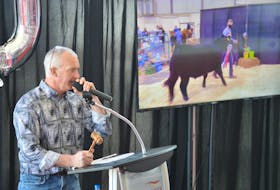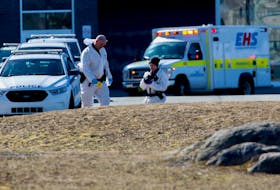By Rob Löfstedt
Commentary
This is in response to the report on the large coyote caught recently in P.E.I.
Last year, our miniature Schnauzer, Angus, was attacked by coyotes directly behind our house. On Oct. 17th this year, he was killed; not eaten, but skinned and left in the pasture.
We have more than our fair share of coyotes on the farm and, I dare say, we are destined to encounter more.
We have been on the farm for more than 20 years and used to be able to walk through the woods with our two dogs off leash. Not so nowadays. We often hear the coyotes howling at night and have to walk with our remaining dog (Angus' brother) on a leash. Also, at night we wear a powerful head lamp for some feeling of security, not knowing what lurks in the back garden or just behind the garage, where Angus was attacked. We have a powerful light in the yard and others scattered around on the house and garage. Last night the garage light motion detector tripped and the area next to the garage lit up. The night was perfectly calm, so I knew it had not been tripped by moving vegetation. I took my large and fearsome stick and went out. There was a coyote, not 40 yards from the house.
Our neighbour cannot keep his heifers in his low pasture any more; they have been chased through the fences repeatedly. The same has happened on our property. I go out with trepidation at night and my dairy farmer neighbour does too. The people on our road no longer take walks with their dogs in the evening. We are being held hostage.
On our road, there have been four separate human-coyote encounters (two in which the humans were followed at close range) but no one has yet been attacked. Common wisdom suggests that coyotes are not yet habituated to man and pose no significant risk to humans. But a perusal of the lay and scientific literature suggests that this is not so. In the Maritimes, coyotes have only killed one person but there have been other attacks on humans, even here in the Maritimes. A report from California has documented 89 attacks between 1987 and 2003. In 77 of these encounters, coyotes stalked children, chased individuals and threatened adults. In 35 incidents, where coyotes stalked or attacked children, the possibility of serious or fatal injury appeared likely if the child had not been rescued (Coyote attacks: an increasing suburban problem. Timm et al. North Am. Wildlife and Nat. resources conf. Spokane Washington. March 2004).
Coyotes are not native to P.E.I. I suspect many people are not aware of this. They were first seen in Canada in about 1930, in the Maritimes in 1950, on P.E.I. in about 1983 and in Newfoundland in 1987. We moved to our farm in 1986 and saw none at that time. However, their presence has become more and more obvious over the years. The coyote (Canis latrans) has interbred with the Eastern and Red wolf (as well as domestic dogs) and is substantially larger than its western counterpart. In fact, in some scientific papers, reference is made to "coywolves" not coyotes. So, these animals are large and intimidating.
Because coyotes are apex predators on P.E.I. and have no natural enemies (apart from humans), I suspect the population on P.E.I. will continue to grow until urban areas are penetrated. This process has been well documented in many areas in the U.S. and Canada.
Obviously I am on a personal mission but I am also a scientist. I am fully aware that anecdotes and hyperbole can stir up unwarranted hysteria and unjustified responses to perceived threats. Therefore, together with colleagues at UPEI and with planned collaboration with colleagues in the department of Forests, Fish and Wildlife (P.E.I.) we are developing a coyote reporting website similar to the red fox reporting site already used by the UPEI department of biology. Hopefully we will be able to provide objective data where today none exists; data on human-coyote interaction, stock and pet losses and general population data. With this information in hand, we can decide if coyotes are a real or perceived problem on P.E.I. We will also have a rational basis for deciding on control measures, should they be required.
Dr Rob Löfstedt is professor of reproductive endocrinology and clinical reproduction (theriogenology) with the department of health management,
Atlantic Veterinary College.








